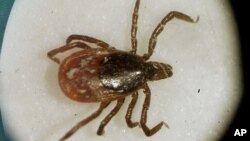Lyme disease - a painful, debilitating disease spread by ticks - was identified only about 40 years ago. But researchers say the bacteria that causes it dates back to the age of the dinosaurs... and those ancient roots may have made it difficult to treat.
The bacterium that causes Lyme disease was present at least 15 million years ago, some 12 million years earlier than the appearance of modern humans.
Researchers at Oregon State University discovered a diseased tick in ancient fossilized amber from the Dominican Republic. The tick was dissected and examined with a powerful microscope by George Poinar, an expert in the detection of ancient microbes.
When he drilled into the amber and opened up the tick, Poinar said he saw the same spirochete-like bacteria, called Borrelis, which causes Lyme disease today.
“You can see spirochetes. They are still there. They are not moving, but they are frozen in different positions, kind of curving this way and that way. It almost looks like a flash photograph of these creatures swimming around. They are in all different positions in the tick on top of each other squirming around. So, you know the tick was heavily infected,” said Poinar.
The discovery of the ancient tick and Lyme bacteria was reported in the journal Historical Biology.
Bacteria are an ancient group of microbes dating back about 3.6 billion years, almost as old as Earth itself. They are rarely preserved in the fossil record, except in amber, which is hardened tree sap.
Poinar, a professor emeritus with OSU's Department of Integrative Biology, said Lyme bacteria evolved over millions of years, likely becoming resistant to efforts to treat them in humans.
While Lyme disease is easily vanquished with antibiotics soon after an infection, Poinar notes that its symptoms often are mistaken for other conditions, and as time passes before it's recognized, it becomes chronic and increasingly difficult to treat.
“It’s much harder after the spirochetes get into the system and then lodge in various parts of the body. Then it’s very difficult [to treat]. And there are various experimental treatments that are being done out there.”
Lyme disease affects the joints, heart and central nervous system. People can become infected anywhere in the world through the bite of an infected tick carried by mice or deer.
One experimental and expensive treatment is immunoglobulin or IVIG, a blood product administered intravenously. IVIG is made up of pooled antibodies extracted from the plasma over one thousand blood donors. The treatment is usually reserved for people with autoimmune disease and blood disorders.
The bacterium that causes Lyme disease was present at least 15 million years ago, some 12 million years earlier than the appearance of modern humans.
Researchers at Oregon State University discovered a diseased tick in ancient fossilized amber from the Dominican Republic. The tick was dissected and examined with a powerful microscope by George Poinar, an expert in the detection of ancient microbes.
When he drilled into the amber and opened up the tick, Poinar said he saw the same spirochete-like bacteria, called Borrelis, which causes Lyme disease today.
“You can see spirochetes. They are still there. They are not moving, but they are frozen in different positions, kind of curving this way and that way. It almost looks like a flash photograph of these creatures swimming around. They are in all different positions in the tick on top of each other squirming around. So, you know the tick was heavily infected,” said Poinar.
The discovery of the ancient tick and Lyme bacteria was reported in the journal Historical Biology.
Bacteria are an ancient group of microbes dating back about 3.6 billion years, almost as old as Earth itself. They are rarely preserved in the fossil record, except in amber, which is hardened tree sap.
Poinar, a professor emeritus with OSU's Department of Integrative Biology, said Lyme bacteria evolved over millions of years, likely becoming resistant to efforts to treat them in humans.
While Lyme disease is easily vanquished with antibiotics soon after an infection, Poinar notes that its symptoms often are mistaken for other conditions, and as time passes before it's recognized, it becomes chronic and increasingly difficult to treat.
“It’s much harder after the spirochetes get into the system and then lodge in various parts of the body. Then it’s very difficult [to treat]. And there are various experimental treatments that are being done out there.”
Lyme disease affects the joints, heart and central nervous system. People can become infected anywhere in the world through the bite of an infected tick carried by mice or deer.
One experimental and expensive treatment is immunoglobulin or IVIG, a blood product administered intravenously. IVIG is made up of pooled antibodies extracted from the plasma over one thousand blood donors. The treatment is usually reserved for people with autoimmune disease and blood disorders.








